Food inflation crisis may be over, but high prices are here to stay
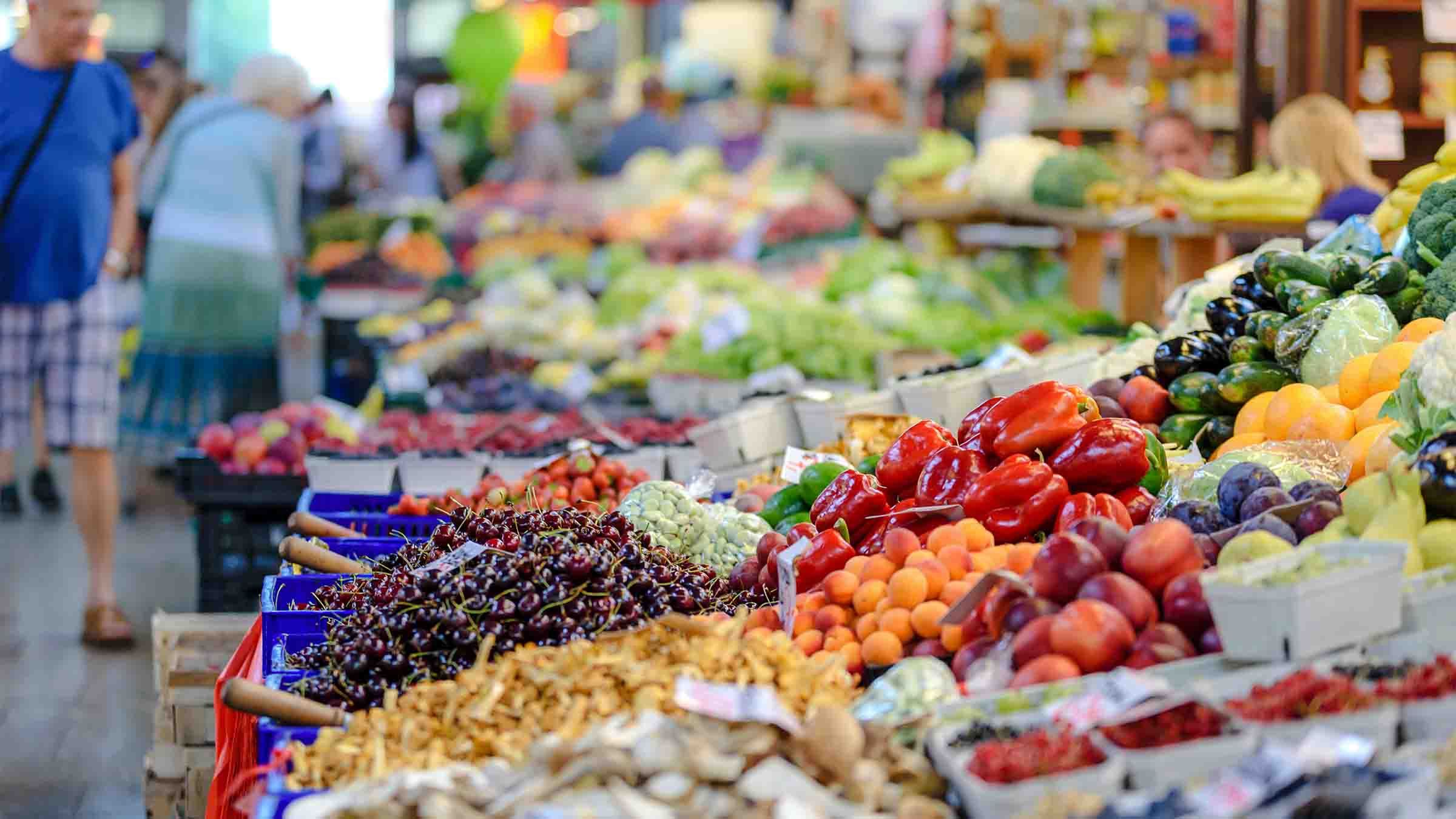
That is the grim reality that is being keenly felt by many Canadian households

Article content
Tyler Fulton is about to ship 130 of his female cows to market after more than a year of feeding and raising them. The fall is one of the few times he can realize some revenue from his 6,000-acre farm, which belonged to his grandparents and parents before him, in the small Manitoba town of Birtle. The good news is that in his 17 years of running the farm, beef prices have never been higher.
Advertisement 2
Story continues below
Article content
“Prices for cattle have been climbing now, probably for about 10 years,” he said.
But it’s also important to note that his operating costs compared to just five years ago are significantly higher when it comes to equipment, labour and feed.
Fulton’s cattle farm and beef prices in general are part of the larger story about food inflation, which seems to have finally been tamed after three years of rapid increases. Year-over-year food inflation was at 2.4 per cent in August, down from its peak of 11.4 per cent in January 2023, but that’s still higher than the headline rate of two per cent, the Bank of Canada’s target.
The hard truth, however, and one keenly felt by many Canadian households, is that slowing inflation doesn’t translate into lower prices for prime rib and other food products, such as olive oil and infant formula, that have significantly jumped during the past five years.
Article content
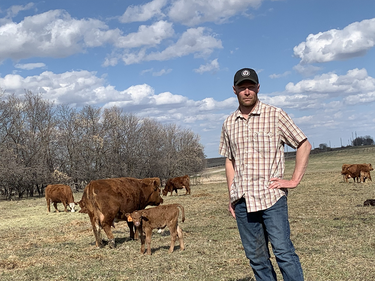
The grim reality is that higher grocery prices are likely here to stay since the factors keeping some prices elevated are highly idiosyncratic to specific markets and unlikely to be brought down by the broad-based policy prescriptions currently on the table.
“We’ve looked at the topline and said prices are going up, so why are prices going up?” Mike von Massow, a food economy professor at the University of Guelph, said. “The truth is, these are much more complicated issues, and they are really individual.”
Advertisement 3
Story continues below
Article content
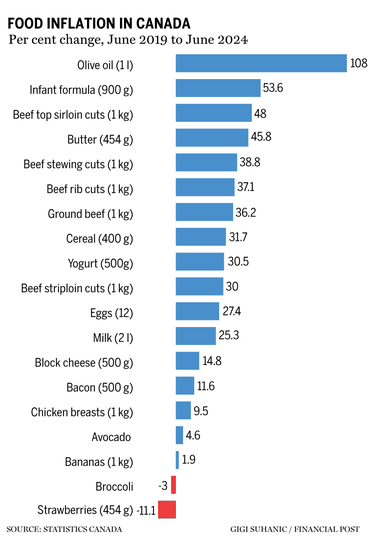
Take beef. In the five-year period starting June 2019, beef prices rose more than the pace of overall food inflation. During that time, the price of beef top sirloin cuts jumped 48 per cent, beef rib cuts increased 37.1 per cent, beef striploin cuts rose almost 30 per cent and beef stewing cuts increased by 38.8 per cent.
Kevin Grier, a livestock and grocery market analyst, said these price increases are due to a perfect storm of factors, such as drought and the historic cycle of herd sizes.
“There is something called a cattle cycle; we’ve had a cattle cycle for 150 years,” he said. “The herd gets smaller and smaller because the returns to the farmer or the rancher are poor.”
Once supply falls too low, demand starts to drive prices up again and farmers start to expand their herds again. There are usually 10 to 15 years between the peak of the herd and the next peak of the herd, Grier said.
“The cow herd in North America is getting smaller and smaller, and that’s the primary reason why beef prices are higher,” he said. “It’s going to get worse because those ranchers are finally starting to make money because the herd has gotten so small and they’ve become more valuable.”
As for the weather, some regions of Canada and the United States have in recent years experienced droughts, which present a host of complications for ranchers, including the loss of good pastureland for their herds and an exponential rise in feed prices.
Advertisement 4
Story continues below
Article content
Fulton experienced a drought on his farm in 2021 and again in 2023. He said ranchers must make hard economic choices when this happens.
“Ranchers make a decision on whether or not they can rationalize paying the high prices of hay or sell some of those mother cows,” he said, “which would reduce the need for feed.”
Fulton said losing those mother cows essentially means a rancher will lose the economic driver of their herd since you have fewer breeders.
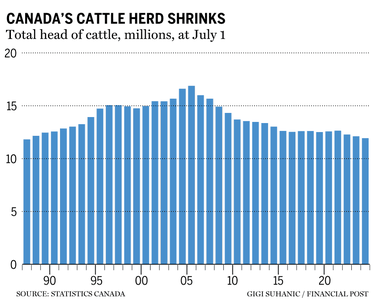
The extent of the herd shrinkage was highlighted by a recent report by Statistics Canada. As of July 1, the herd in Canada was 1.4 per cent smaller than last year. Farmers currently have 11.9 million cattle and calves, the smallest herd size on record since 1987.
The total amount of calves and cattle slaughtered decreased by 4.6 per cent in the first six months of 2024 compared to last year. However, exports climbed by 15.5 per cent in the same period, supported by higher prices in the international market.
“Right now, we’re dealing with a unique situation where, coincidentally, the droughts and the demographics of the industry have driven the supply down so tight that it now has high prices,” Fulton said.
He said beef demand is very resilient and he hasn’t seen it fall off in recent years, which means the rising price of beef remains a supply story.
Advertisement 5
Story continues below
Article content
“If it wasn’t moving at these prices, it would be backing up, it would be going into storage,” Grier said. “The other part of the equation is that beef demand in Canada and particularly in the United States has been great. If we were not buying them, these prices would not be that high.”
More than beef
The price of beef isn’t the only one outpacing overall food inflation. For example, the average monthly price for one litre of olive oil rose to $17.14 from $8.24 between June 2019 and June 2024, according to Statistics Canada data.
Market watchers agree there are macroeconomic explanations for these stubbornly high prices, including knock-on effects from supply chain disruptions, increased crop prices during the pandemic and, more recently, a weakening exchange rate for the Canadian dollar and higher oil prices than five years ago despite the recent declines.
But in the case of olive oil, the main factor at play, just like with beef, is multiple years of drought.
The biggest olive-oil-producing countries include Spain, Greece, Italy and Turkey. With unfavourable growing conditions there, olive oil producers are now producing much less product compared to a few years ago.
“Because we get many of our products from a relatively small area, we are susceptible to big changes in prices due to big changes in availability,” von Massow said. “When we look at what happens with olive oil, there are not that many places in the world that produce it, so when we do get a crop failure, it is much more isolated and has a much more significant impact on prices.”
Advertisement 6
Story continues below
Article content
Article content
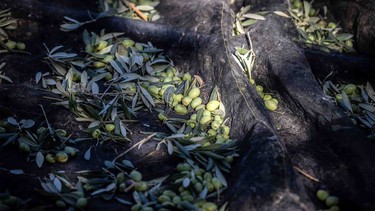
One of the world’s largest olive oil producers in Spain is Deoleo SA, whose brands include Carbonell, Carapelli, Bertolli and Sasso.
During the annual stakeholder meeting this past summer, chief executive and chair Ignacio Silva highlighted the difficulties brought on by two consecutive bad harvest seasons, with the company having to drop its production numbers as a result.
“The strength of Deoleo’s key brands, efficiency in commercial management and cost control have been central to defending and maintaining our unit gross margin through 2023,” he said, according to a release.
Von Massow said any improvement in olive oil prices will depend on whether the biggest olive-growing countries get a good harvest year. But that likely won’t happen this year since Greece, Italy and Spain are currently experiencing the worst drought in decades.
Another example that made headlines during the inflation crisis was infant formula, whose monthly average price in June had jumped by 53.56 per compared to five years ago. The story of why infant formula prices are so high is also a complicated one.
In 2022, Abbott Laboratories, one of the primary manufacturers of baby formula, had its plant in Sturgis, Mich., shut down for months after the U.S. Food and Drug Administration detected Cronobacter sakazakii bacteria in the plant.
Advertisement 7
Story continues below
Article content
Elecare Similac and Alimentum Similac powdered infant formulas were recalled, causing a massive shortage in the U.S. and Canada that lasted from 2022 into 2023.
At the time, Canada relied on a very limited number of producers, primarily importing from the two biggest ones: Abbott Laboratories and Reckitt Benckiser Group PLC.
“When you only have two or three players, it becomes a supply and demand issue,” said Michael Graydon, chief executive at Food, Health and Consumer Products of Canada, a national association that represents members from the manufacturing side of the food industry.
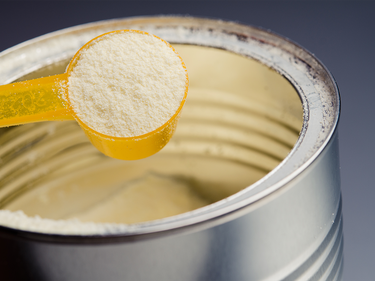
Canada also has stringent regulatory requirements for baby formula. Graydon said these manufacturers must clean their plants before making products for Canadian consumers.
To help stop the shortage, Health Canada introduced an interim policy that allows the importation of other infant formulas on the market while their manufacturers wait for final approval from the agency. This policy has been extended until the end of 2025.
“Until recently, there was zero manufacturing of infant formula in Canada; it’s all imported from the United States,” Graydon said. “The regulatory environment that exists here in Canada kind of chased away the manufacturers.”
Advertisement 8
Story continues below
Article content
In March, the Canadian Food Inspection Agency approved infant formula manufacturer Canada Royal Milk ULC as a producer here. The manufacturer is a subsidiary of China-based company Feihe International Inc., which recently built a plant in Kingston, Ont.
The creation of one domestic manufacturer may not fix the supply issues, but it is an important first step for regulators.
Generally, however, most food prices are up compared to five years ago, though there are some exceptions. For example, the average price of strawberries was down by a bit more than 11 per cent in June and broccoli was down nearly three per cent.
“We’re coming into the Canadian season and so depending on the year you are comparing it to, you may have had a bad growing season in 2019 and a good growing season in 2024,” von Massow said. “It was a good year for strawberries this year, but a bad year for peaches, for example.”
Pressure grows
Since food prices began to soar in 2022, the federal government has faced public pressure to come up with policy solutions to fix the problem. Grocery chains have also been under the spotlight.
Chief executives from Canada’s five major grocery retail chains (Loblaw Cos. Ltd., Metro Inc., Empire Ltd., Wal-Mart Canada Corp. and Costco Wholesale Canada Ltd.) all appeared before a House of Commons agriculture committee studying the matter in 2023.
Advertisement 9
Story continues below
Article content
During their testimonies, the CEOs defended their companies against accusations of price gouging and pointed to increased costs in the supply chain as the main driver of retail price increases.
The five companies represent roughly 80 per cent of the market and there has been significant market consolidation since there were eight major grocery chains in 1986, according to a report by the Competition Bureau.
The bureau said there needs to be more choice in the grocery market so Canadians can have more price competitiveness. But some argue the Canadian market is already competitive.
Article content

“I am one of those people who believes that the Canadian grocer market is a very competitive market,” Grier said. “I believe the reason we don’t have more foreign companies coming here is because they know it’s already a competitive market with not much low-hanging fruit.”
He points to the failure of Target Corp.’s expansion into Canada in 2015 as an example of how difficult it is for a foreign competitor trying to compete here.
Industry Minister François-Philippe Champagne has been courting foreign grocery chains from Europe and the U.S., but nothing has come from those efforts so far.
“Even the Competition Bureau’s report said they talked to a foreign grocer, and they said they looked at the Canadian market and they don’t know if they can compete,” von Massow said. “The problem is it’s not just building stores and building a bunch of stores on expensive real estate; it’s also building distribution infrastructure and building relationships with suppliers.”
Advertisement 10
Story continues below
Article content
Some of the key policies introduced by the federal government, such as a grocery rebate for families and the creation of a grocery code of conduct, do not provide solutions to address high prices in the near term.
“The grocery code of conduct is not a bad thing to do, but I think it has been arbitrarily and incorrectly held up as something that will reduce food prices,” von Massow said.
The code of conduct is expected to be launched in June 2025 and will be membership-based. It’s designed to help grocery retailers, manufacturers and producers settle negotiations more fairly and will hopefully give the nearly 10,000 independent grocers a more level playing field.
Graydon, chairman of the interim board for the code, said it’s designed to help reduce the compliance fees that manufacturers are hit with when their orders do not meet forecasts set by the retailer and the manufacturer. The code could also provide better negotiated outcomes on these matters.
“I think it will help stabilize pricing; it’s not going to have a deflationary impact overnight,” he said. “The compliance fines manufacturers pay are material; they’re in the billions of dollars.”
Graydon said reducing those fines could help manufacturers reinvest in their businesses and could help improve pricing by suppliers in the long term.
Advertisement 11
Story continues below
Article content
All five major grocery retailers have agreed to sign the code. Loblaw initially opposed joining, arguing it would be inflationary, but dropped that argument in May. Walmart and Costco agreed to sign on in July.
Accusations of price gouging have been levied at the big grocery chains, which are the face of rising food prices. A report released this year also confirmed the “shrinkflation” phenomenon, where the quantity sizes of one in five products found at Loblaws, Walmart and Metro stores were smaller than five years ago despite being the same price.
Loblaw made record profits at the height of the food inflation crisis in 2022 and 2023, but it has said this mostly stemmed from its growth in pharmacy sales.
In the meantime, food insecurity has only grown. Food Banks Canada said there were nearly two million visits to food banks in 2023, a nearly 80 per cent increase from 2019.
A global problem
Food costs are becoming a political and economic issue elsewhere, too. In August, U.S. vice-president and presidential candidate Kamala Harris called for a new federal law to “ban price gouging on food” during a campaign speech in North Carolina.
In February, the Federal Trade Commission (FTC), the consumer protection agency in the U.S., filed a suit to block the merger between supermarket giants Kroger Co. and Albertsons Cos. Inc. The trial began in August, with the FTC arguing that the merger would create less competition in the grocery market.
Advertisement 12
Story continues below
Article content
In March, the FTC also issued a report based on data collected from major U.S. grocery chains that determined that bigger retailers such as Walmart Inc. and Amazon.com Inc. gained a competitive advantage during the pandemic. The report also cast doubt on the assertion that price increases were mainly driven by added costs.
In the United Kingdom, a survey by the Food Foundation said that 15 per cent of households experienced food insecurity in January. U.K. Prime Minister Keir Starmer has delayed post-Brexit border food checks on fruits and vegetables imported from the European Union, which is estimated to annually cost British consumers 200 million pounds.
And Australia has held countless inquiries into grocery prices and the grocery industry. Its federal government has decided to make participation in its existing grocery code of conduct mandatory.
As governments attempt to grapple with rising food prices, Fulton said he wants Canadian consumers to know that there is a disconnect between the cost you may see at the grocery store and what the farmer is receiving at the beginning of what is a complex value chain.
“A perfect case in point, I think, is the beef industry, where these inflationary factors have been developing for three to four years, and it’s really only now that I can say that it’s profitable to be a cattle rancher,” he said.
• Email: [email protected]
Bookmark our website and support our journalism: Don’t miss the business news you need to know — add financialpost.com to your bookmarks and sign up for our newsletters here.
Article content





Comments